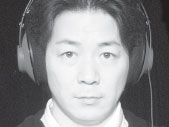
| International teamwork: The two media artists Masayuki Akamatsu (Japan) and Wolf Helzle (Germany) designed a new media artwork together. It deals with the recognition of our individuality in relation to humankind and interacts with the audience. | |||||
INSTALLATION |
INTERACTION |
EXTENSION |
|||
| Ocean_v1 is shown on a flatscreen, connected with an face detection system, based on an apple or windows computer. From a database with over 15.000 human faces, which Helzle collected over the last years from around the world, a selection of similar faces is projected on to a flat surface at a speed of 60 faces per second. At this speed, it looks like only one single face is present, even though it is being generated from many different ones. Several similarities can be found, such as the distance between the left and right eye or the distance between the nose and mouth... after a time, another selection is shown. | Furthermore the images are moved, scaled and rotated according to the audiences' face movements. If the audience turns its head, the picture turns its head too. In addition, the speed can be altered and the image size can be scaled to eye- and head movements. | The moment Wolf Helzle photograph the visitors in the exhibition, their faces immediately become a part of the database. This can be of interest especially when looking for someone's face. For this reason, a special selection can also display the last projected portraits, or the portraits projected that whole day. | |||
|
|
|
|||
CONCEPT |
|
Part 1: Philosophy |
Part 2: Technology Part 3: Algorithm |
EXAMPLE |
||
|
|
|
|
|
|
ARTISTS
|
|||
One of the central questions asked by the media artist Wolf Helzle is: ÅgWhat is the relationship between the individual and mankind?Åh He asks this question in performances, photography, videos and installations where he integrates people from all around the world. He works together with musicians of different styles and other experimental art forms. Integrating the audience is an important part in his artwork. Over the last five years, for example, Wolf Helzle has collected more than 15.000 portraits from around the world. Curriculum Vitae Exhibition shortlist Wolf Helzle Media Artist |
Masayuki Akamatsu produced many media artworks that employ computer and networking facilities, focusing on the relationship between an artwork and the audience and the autonomy of an artwork itself. His works include: "incubator" (1999), which projects audio-visual events using fifty computers; "Time Machine!" (2002), which visualizes the audience's experience of time in real time; "Flesh Protocol" (2002), which controls the performerÅfs body with a computer. He also performs live electronic music. He has not only performed as a solo artist, but also in many groups. He has published many books and organized events including the "DSP Summer School". Curriculum Vitae Exhibition/Concert Shortlist Masayuki Akamatsu IAMAS |
||










